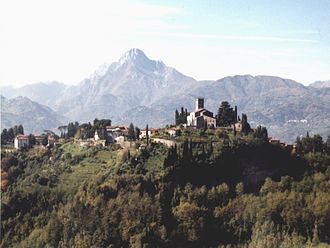Tuscany
Region of Italy

Tuscany (Italian: Toscana) is a region in central Italy known for its rich cultural heritage, stunning landscapes, and significant influence on high culture. It is bordered by Liguria to the northwest, Emilia-Romagna to the north, Marche to the northeast, Umbria to the east and southeast, Lazio to the southeast, and the Tyrrhenian Sea to the west. The regional capital is Florence, a city renowned for its history, art, architecture, and cultural influence.
Geography[edit]
Tuscany covers an area of about 22,993 square kilometers and has a population of approximately 3.8 million inhabitants. The region is characterized by its diverse landscapes, which include the Apennine Mountains, fertile plains, and a long coastline along the Tyrrhenian Sea.

The region is famous for its rolling hills, particularly in areas such as the Chianti region, the Val d'Orcia, and the Maremma. The Arno River is the most significant river in Tuscany, flowing through Florence and Pisa before emptying into the Tyrrhenian Sea.
Climate[edit]
Tuscany has a varied climate, with coastal areas experiencing a Mediterranean climate, while inland areas have a more continental climate. Summers are generally hot and dry, while winters are mild and wet. The region's climate is conducive to agriculture, particularly the cultivation of grapes and olives.
History[edit]
Tuscany has a rich history that dates back to the Etruscans, an ancient civilization that inhabited the region before the rise of the Roman Empire. The Etruscans were known for their advanced culture and significant contributions to art and architecture.
During the Middle Ages, Tuscany was a center of commerce and culture, with cities like Florence, Pisa, and Siena becoming powerful city-states. The region played a crucial role in the Renaissance, a period of great cultural and artistic achievement that began in Florence in the 14th century.
Culture[edit]
Tuscany is renowned for its cultural heritage, which includes art, architecture, music, and literature. The region is home to numerous UNESCO World Heritage Sites, including the historic centers of Florence, Siena, and San Gimignano.

Art and Architecture[edit]
Tuscany has been a center of art and architecture for centuries. The region is home to masterpieces by artists such as Leonardo da Vinci, Michelangelo, and Botticelli. The architecture of Tuscany is characterized by its use of local materials, such as marble and terracotta, and its emphasis on harmony and proportion.
Cuisine[edit]
Tuscan cuisine is known for its simplicity and use of fresh, high-quality ingredients. Traditional dishes include ribollita, pappa al pomodoro, and bistecca alla fiorentina. The region is also famous for its wines, including Chianti, Brunello di Montalcino, and Vernaccia di San Gimignano.
Economy[edit]
The economy of Tuscany is diverse, with significant contributions from agriculture, industry, and tourism. The region is known for its production of wine, olive oil, and other agricultural products. Tuscany is also a popular tourist destination, attracting millions of visitors each year to its historic cities, beautiful countryside, and cultural attractions.

Tourism[edit]
Tourism is a major industry in Tuscany, with visitors drawn to its historic cities, picturesque landscapes, and cultural heritage. Popular tourist destinations include Florence, Pisa, Siena, and the coastal areas of the Maremma and the Tuscan Archipelago.
Related pages[edit]
Ad. Transform your life with W8MD's Budget GLP-1 injections from $75


W8MD offers a medical weight loss program to lose weight in Philadelphia. Our physician-supervised medical weight loss provides:
- Weight loss injections in NYC (generic and brand names):
- Zepbound / Mounjaro, Wegovy / Ozempic, Saxenda
- Most insurances accepted or discounted self-pay rates. We will obtain insurance prior authorizations if needed.
- Generic GLP1 weight loss injections from $75 for the starting dose.
- Also offer prescription weight loss medications including Phentermine, Qsymia, Diethylpropion, Contrave etc.
NYC weight loss doctor appointmentsNYC weight loss doctor appointments
Start your NYC weight loss journey today at our NYC medical weight loss and Philadelphia medical weight loss clinics.
- Call 718-946-5500 to lose weight in NYC or for medical weight loss in Philadelphia 215-676-2334.
- Tags:NYC medical weight loss, Philadelphia lose weight Zepbound NYC, Budget GLP1 weight loss injections, Wegovy Philadelphia, Wegovy NYC, Philadelphia medical weight loss, Brookly weight loss and Wegovy NYC
|
WikiMD's Wellness Encyclopedia |
| Let Food Be Thy Medicine Medicine Thy Food - Hippocrates |
Medical Disclaimer: WikiMD is not a substitute for professional medical advice. The information on WikiMD is provided as an information resource only, may be incorrect, outdated or misleading, and is not to be used or relied on for any diagnostic or treatment purposes. Please consult your health care provider before making any healthcare decisions or for guidance about a specific medical condition. WikiMD expressly disclaims responsibility, and shall have no liability, for any damages, loss, injury, or liability whatsoever suffered as a result of your reliance on the information contained in this site. By visiting this site you agree to the foregoing terms and conditions, which may from time to time be changed or supplemented by WikiMD. If you do not agree to the foregoing terms and conditions, you should not enter or use this site. See full disclaimer.
Credits:Most images are courtesy of Wikimedia commons, and templates, categories Wikipedia, licensed under CC BY SA or similar.
Translate this page: - East Asian
中文,
日本,
한국어,
South Asian
हिन्दी,
தமிழ்,
తెలుగు,
Urdu,
ಕನ್ನಡ,
Southeast Asian
Indonesian,
Vietnamese,
Thai,
မြန်မာဘာသာ,
বাংলা
European
español,
Deutsch,
français,
Greek,
português do Brasil,
polski,
română,
русский,
Nederlands,
norsk,
svenska,
suomi,
Italian
Middle Eastern & African
عربى,
Turkish,
Persian,
Hebrew,
Afrikaans,
isiZulu,
Kiswahili,
Other
Bulgarian,
Hungarian,
Czech,
Swedish,
മലയാളം,
मराठी,
ਪੰਜਾਬੀ,
ગુજરાતી,
Portuguese,
Ukrainian